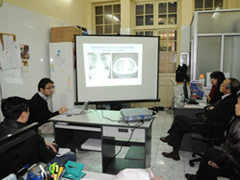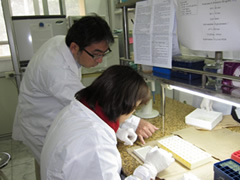Project News
2012-03-07
Training on laboratory diagnosis of Histoplasma
Initially, let's explain Histoplasmosis in brief, because it is not a well-known disease. Histoplasmosis is also known as "Cave disease", caused bythe etiologic agents belonging to the fungus Histoplasmacapsulatum. This fungus infects not only immunocompromised patients such as HIV-infected patients but also healthy people. The fungus Histoplasma exists as a mold in the soils, rapidly grows in bird or bat droppings and its infection occurs when a person inhales airborne dusts which contain microscopic fungal spores. Acute infection causes coughing and other symptoms similar to Influenza such as fever, fatigue, muscular pain. Chronic infection results in preumonia, respiratory failure, haemoptysis and other symptoms similar to tuberculosis. Histoplasma group is spread over the world, especially in Mississippi river valley (USA), Central and South American countries, Western Asia, Southeast Asia, and Australia. The number of Histoplasma-infected patients in Japan has recently increased and most of them got infected in Northern and Central America, and Southeast Asia. In fact, the profile of spreading, transmission source and risk factors still remains unknown in the Southeast Asia. Although Histoplasmosis is considered as a hazardous infectious disease as well as Penicilliosis (type Maruneffei) in Vietnam, the number of patients and cases are not reported. This is ascribed to the difficulty and unfamilar of diagnosis (level 3 pathogen) .
Training course on laboratory diagnosis of Histoplasma was organized from February 28th to March 5th, 2012 with the instruction of Dr. Ohno (from National Institute of Infectious Diseases, Japan). Participants were Dr. Ha and 3 staffs from Laboratory of Rare Bacteria (National Institute of Hygiene and Epidemiology) and 3 staffs from Department of Laboratory, Bach Mai Hospital The training course covered a wide-range knowledge of Histoplasma from theory of diagnosisto practice on detection method from the soil samples, GMT (Good Microbiology Technique), culture method, genetic diagnosis method and ELISA method of antibody detection. By using samples from fever patients (unidentified cause), participants carried out ELISA and nested PCR specific to Histoplasma. Eight samples were identified as positive among 37 tested samples from medical centers, indicating the presence and the possible rate of infected cases in the northern Vietnam. This training course might shed light on unrecognized Histoplasmosis as a new infectious disease in Vietnam. Furthermore, strengthening the capacity of Histoplasma laboratory diagnosis is expected to contribute to prevention system against Hitoplasmosis in Vietnam in the future.
 Dr. ONO's lecture
Dr. ONO's lecture
 Practice in laboratory
Practice in laboratory
- About JICA
- News & Features
- Countries & Regions
- Our Work
- Thematic Issues
- Types of Assistance
- Partnerships with Other Development Partners
- Climate Change / Environmental and Social Considerations
- Evaluations
- Compliance and Anti-corruption
- Science and Technology Cooperation on Global Issues
- Research
- JICA Development Studies Program / JICA Chair
- Support for the Acceptance of Foreign HRs / Multicultural and Inclusive Community
- Publications
- Investor Relations
